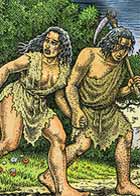Talking Pictures

Ever since Art Spiegelman's landmark Maus (1986), comics and graphic novels have established themselves as a new form of visual-cum-verbal midrash. The best of them, re-imagining texts and the events of history, point beyond themselves.
If Spiegelman paid tribute to his father, a survivor of the Holocaust, the hero of Joann Sfar's The Rabbi's Cat is witness to the vanished Jewish culture of Algiers. Other cartoonists have tackled the text of the Bible, as eloquent as it is famously laconic. R. Crumb (of Fritz the Cat) has recently published his take on the Book of Genesis, rendered in his trademark mix of burlesque, Blake, and Beckett. The Comic Torah, playing the text—and itself—for both pathos and laughs, depicts God as a woman endlessly disappointed in love. Departing from the genre's self-conscious impieties, Yonah Lavery in Talmud Comics injects a note of elegiac reverence into her delicate, gray-shaded treatments of rabbinic texts and figures.
In a class by himself is the Israeli cartoonist Shay Charka. His Hebrew Babba series (named for the hapless, bulbous-nosed protagonist whose name is also the talmudic word for "gate") offers a verbal and visual romp through the Bible, the Talmud, the Zohar, Nahman of Bratzlav, and contemporary Israeli life. In another series, Over the Line, chronicling the experience of a religious West Bank settler like himself, Charka's alter ego informs an incredulous secular journalist that cartoonists are the most pious monotheists of all, since the essence of their craft is the shattering of idols.
This points to a difference between the new midrash and the old. The ancient rabbis were no slouches at kidding around, but for them the key lay finally in the text's infinite meaningfulness, rooted in its divine authorship. Even as intimations of a similar conviction, or of a desire for it, can be teased out of some contemporary midrashists, there's no denying the rip torn by modernity in the fabric of belief—or the price paid in the consequent loss of, paradoxically, creative freedom.
Comments are closed for this article.




